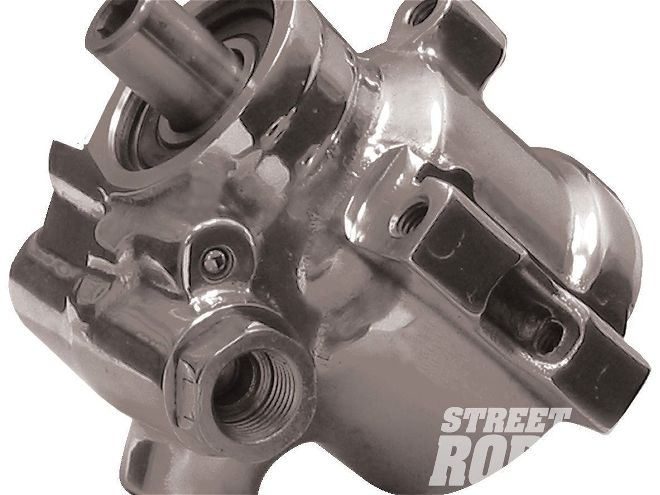
There was a time when power steering was considered to be a convenience accessory; today it seems to be standard on most cars, including many street rods.
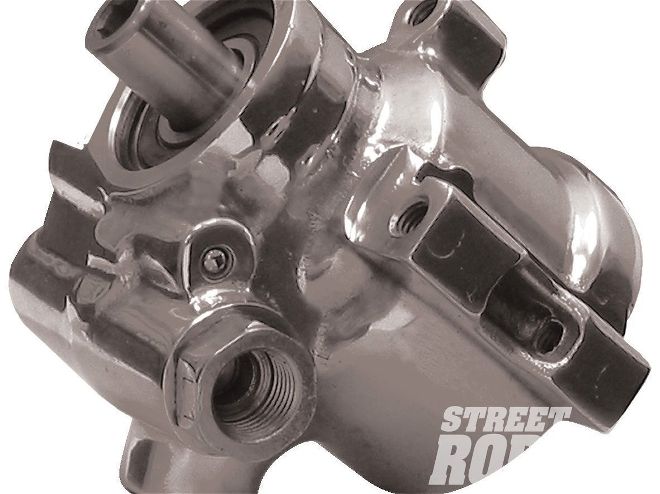 For a clean look and easy packaging, a popular choice is a GM Type II power steering pump that uses a remote reservoir. Borgeson offers them for V-belt or serpentine drives with pressure preset for Mustang rack-and-pinion or GM boxes. Pumps are available in polished or cast finish, with slip-on or AN connections.
For a clean look and easy packaging, a popular choice is a GM Type II power steering pump that uses a remote reservoir. Borgeson offers them for V-belt or serpentine drives with pressure preset for Mustang rack-and-pinion or GM boxes. Pumps are available in polished or cast finish, with slip-on or AN connections.
While power steering on street rods continues to be popular, there are also common complaints about it, usually concerning steering sensitivity. Touchy steering can be an issue with standard steering boxes and it’s quite common when rack-and-pinion steering is used. In most cases it’s the result of mixing and matching parts, but then that’s what we do, so the challenge is to find a way to make the pump and the gear work together.
In street rodding the most commonly used power steering pump is the Saginaw. To get the lowdown on how to tailor a pump to our specific needs we turned to Jeff Grantmeyer at Borgeson for his expertise. “The Saginaw self-contained power steering pump was used widely by all off the Big Three from the ’60s on up into early 2000. That being said, this has resulted in many different variations of this pump throughout the years. We won’t be dealing with the larger Saginaw ‘P-Series’ pump found on early full-size cars and Chevy/GMC medium-duty trucks but rather we’ll examine the standard Saginaw canned ham pump.”
Pump Shafts: The Saginaw self-contained pump was offered with two different pulley shafts. The 5/8-inch nut retained keyway-style shaft was used from its inception until 1974 and the 3/4-inch diameter “press-on” style shaft was used from 1975 and on.
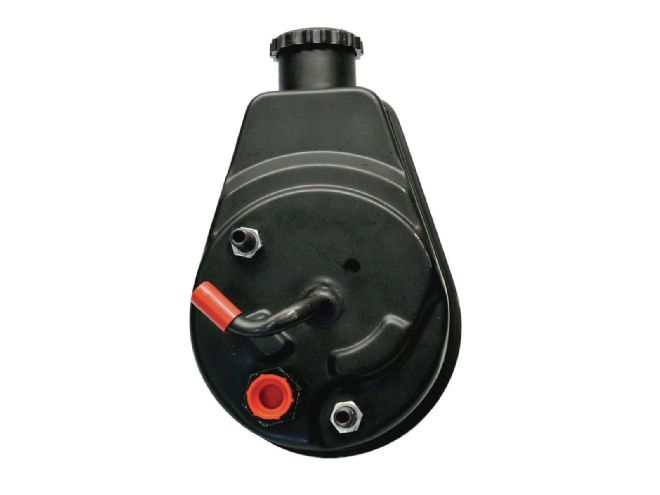 Commonly called the “canned ham” style, Saginaw pumps with integral reservoirs come in a variety of configurations. Note the shape of the return line in the center of the reservoir.
Commonly called the “canned ham” style, Saginaw pumps with integral reservoirs come in a variety of configurations. Note the shape of the return line in the center of the reservoir.
Pressure Hose Connection: The Saginaw self-contained pump was offered with two different high-pressure hose fittings. The 5/8-inch flare connection was used from the beginning until 1979 and a 16mm O-ring connection was used from 1980 on.
Pump Mounting Studs/Holes: The mounting studs/holes changed on the same timeline as the pressure fitting above from SAE to metric.
Pump Reservoir: The Saginaw self-contained pump was offered with way too many to list return hose fitting configurations. The hose return fitting varied completely by original vehicle application. Some reservoirs had returns running up, back, left, right, forward—well, you get the idea. The Saginaw pump reservoirs were even offered with two return fittings for vehicles with a Hydro-Boost brake system.
Pump Flow/Valve Rating: This is another aspect of the pump that varied completely by original application. The OEMs would specify what flow rating was required based on vehicle weight, steering gear piston diameter, and whether or not the pump was running a Hydro-Boost brake system. The Saginaw pump in OEM applications can be set from 2.0 on up to 4.5 GPM.
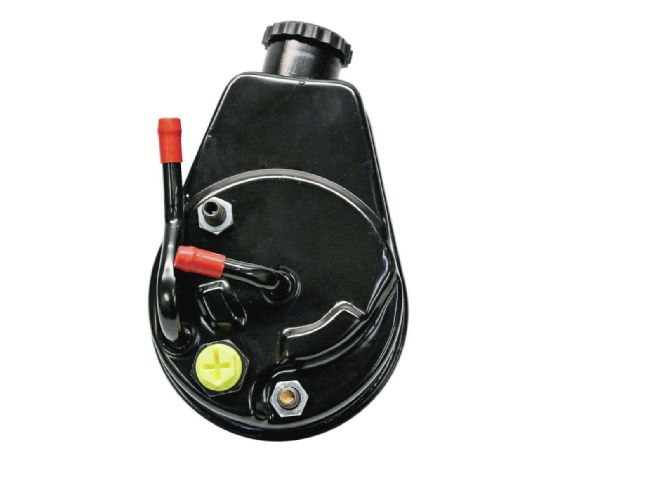 This pump has two returns; the second is for a Hydro-Boost brake system.
This pump has two returns; the second is for a Hydro-Boost brake system.
Pump Bypass Pressure: Just like the flow rating above, the OEMs would specify output pressure based on the original vehicle application and what system the pump was running. Most steering gear applications would run between 1,100-1,300 psi with heavy vehicle high demand applications on up to 1,550-1,600 psi. Rack-and-pinion steering on the other hand is generally happier at a lower operating pressure of 850-950 psi.
Excessive Response/Touchy Steering: This is generally caused by excessive pump pressure. Borgeson offers a pressure reduction kit (PN 899001) that will allow the customer to adjust the internal bypass pressure of the power steering pump (self-contained and Type II with a remote reservoir). This is a very common issue on street rods running a GM pump with a Mustang rack-and-pinion.
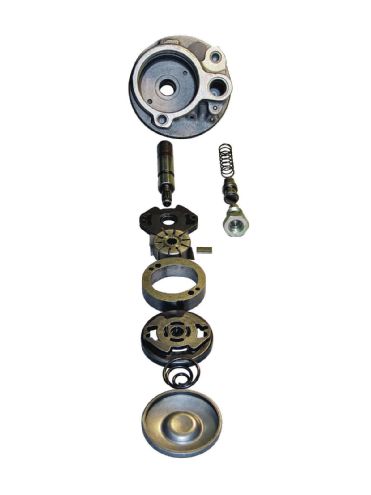 123 Saginaw pumps are not very complicated and relatively bulletproof. The rotor with sliding vanes (1) spins inside the housing (2) to produce pressure. The pressure relief valve assembly is on the right (3).
123 Saginaw pumps are not very complicated and relatively bulletproof. The rotor with sliding vanes (1) spins inside the housing (2) to produce pressure. The pressure relief valve assembly is on the right (3).
Pressure Chart
Power Steering Pump Troubleshooting Tips from Borgeson
Inoperable Pump: There is usually one cause for a new power steering pump to be inoperable: damage during pulley installation. The pulley, although called press-on, is not to be pressed on; a pulley installation tool must be used. Failure to use the proper installation tool can crack the pump housing and cause the pump to be inoperable.
Pump Noise or Groan: This is most commonly caused by a restriction or air trapped in the system. It can also be caused by heat buildup. (This would include a loss of assist.)
No Power Assist After Recent System Service: This is most commonly caused by fluid contamination causing the pressure bypass valve to stick open, resulting in no pump pressure. To fix this, remove the flow valve and ensure the pressure bypass valve moves freely in and out. This can also be a large amount of air trapped in the system.
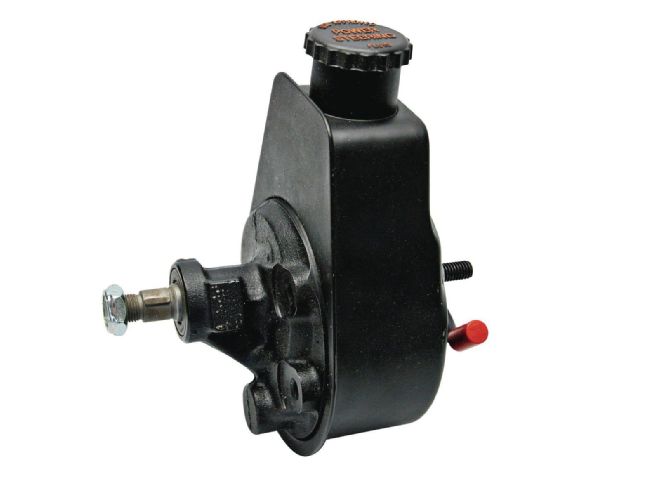 Early pumps had a keyed shaft and pulley that retained with a nut.
Early pumps had a keyed shaft and pulley that retained with a nut.
Hard Steering in Both Directions: This can result from insufficient pump flow/pressure, low power steering fluid level, air trapped in the system, and excessive heat buildup.
Foamy Power Steering Fluid: This is most often caused by either air trapped in the system or a leak in the return line sucking in air.
Reservoir Cap Blows Off: This is most often caused by an air leak. Air is sucked in to the power steering system compressed with the fluid and then expands when it reaches the reservoir, causing an unintended pressure buildup in the reservoir.